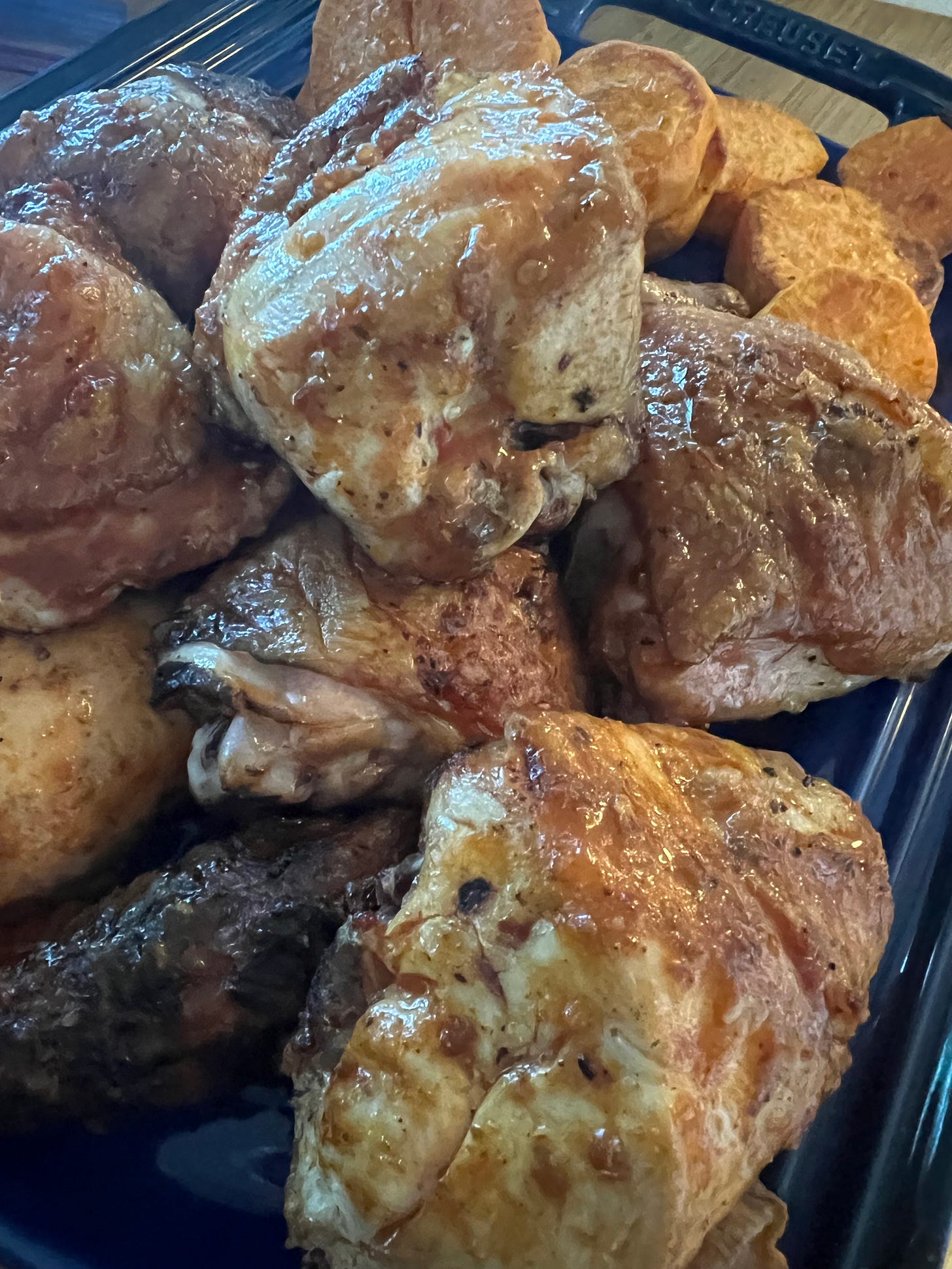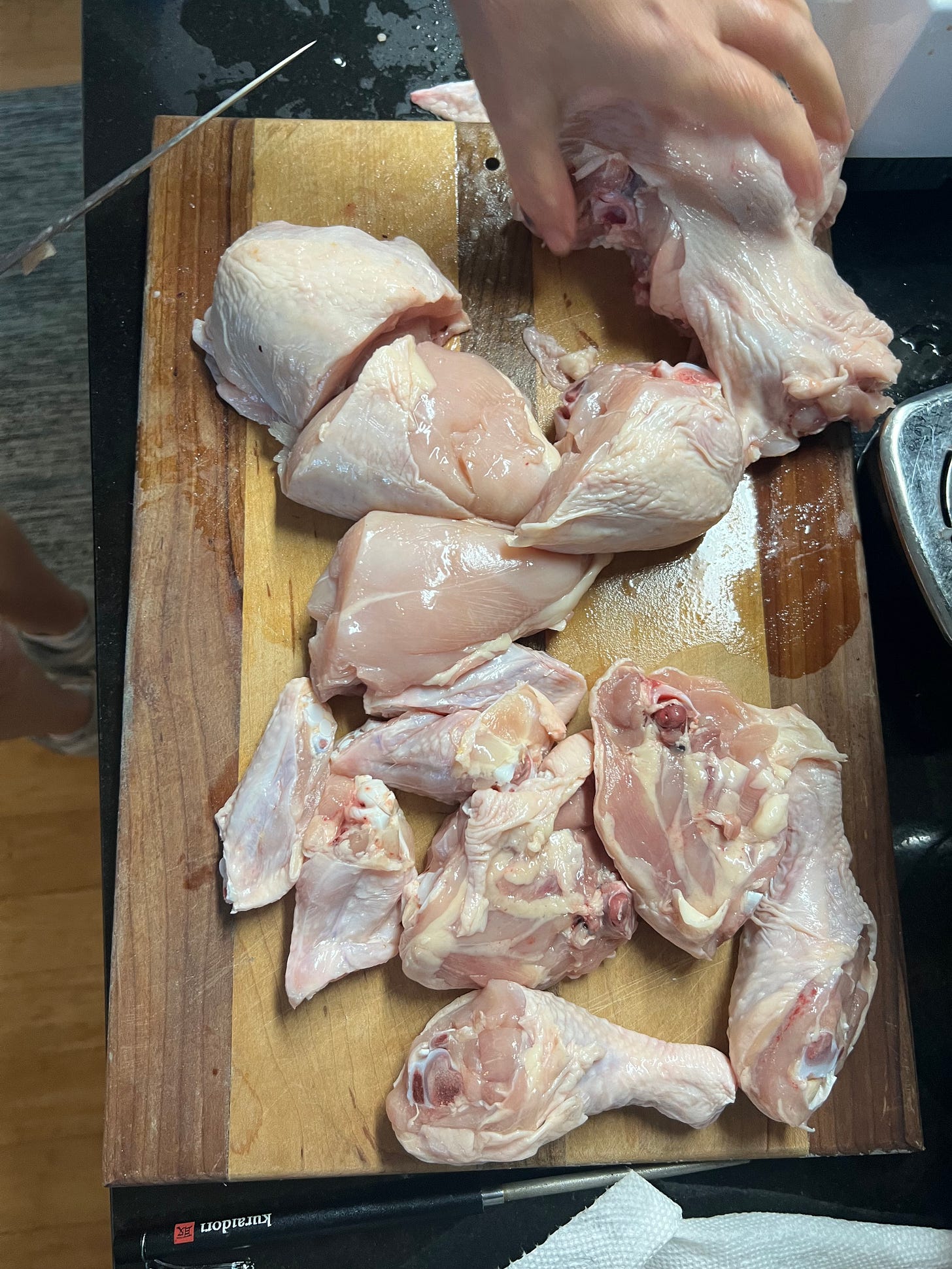Issue #111: Piri Piri Chicken
Grilling at My Sister’s Cottage, Protein’s the Thing, Recipe for Piri Piri Chicken
The summer moves on apace. I’m on a lake in southern Ontario, while Nate and Milo are on a lake in upstate New York. If you are like me and you don’t always know what to do with yourself at a lake, or maybe you have a long drive to get where you are going, why not have a listen to my podcast What’s Burning. For the current episode I interview Italian food philosopher Andrea Borghini and our conversation was like a roller coaster of ideas about food and cooking. Andrea is a philosopher philosopher, not just someone who is thoughtful about food, so he is informed by the millennia-long tradition of deep thought. He is also Italian Italian, so he is well versed in the millennia-long tradition of good eating. Don’t miss it. —Mitchell
This week I’m up at my sister’s cottage on Grandview Lake, about 2 ½ hours northwest of Toronto. While the world is both literally and figuratively on fire elsewhere, we are sitting on her dock wearing sweaters. It is chilly here. At the cottage, I mean, which is located on a corner of the lake that only gets sun in the morning and a cool breeze much of the day. Occasionally, a gust of wind carries smoke from the forest fires burning in other parts of Ontario and in Quebec. Nevertheless, we may start a fire inside tonight to warm up now that the open fire ban has been lifted.
Like all of my siblings—there are four of us, two boys and two girls—my sister Leslie is the cook of her family, and an excellent one at that. Due to various bodily sensitivities and some alternative views on nutrition, she and her girlfriend Judi follow a high-protein, low-carb diet that is limited in other ways, too. No matter, Leslie is a great cook and she manages to make consistently delicious meals better than many less constrained cooks can achieve. It runs in the family, I guess.
(Leslie is also very accommodating of other’s dietary needs, so don’t worry about me, there are plenty of carbs here in my honor.)
Given the amount of high-quality, pasture-raised protein she consumes, it is no surprise that Leslie is particularly adept at cooking meat. At home in Toronto, she has a built-in gas grill outside the door to her kitchen. Here at the cottage her barbecue is less sophisticated, but it is used almost every day, sometimes twice.
My first job in a real restaurant kitchen was on the grill station of a popular bistro in Toronto. It was the late 1980s, between my sophomore and junior year of college. In Toronto, this was the era of grilled swordfish with mango salsa, NY strip steak with hotel butter, and gourmet burgers. The grill station was the busiest on the line. Having moved to New York City after graduation, I haven’t had a lot of opportunity to grill in the last three decades—the last two summers we’ve rented the lakehouse in Ithaca being an exception.
But Leslie has grilled on. Winter, summer, she uses the barbecue like a pro. A couple of nights ago, for dinner at the cottage, she made a favorite, Portuguese piri piri chicken. I had five pieces and then ate it for lunch the next day.
The history of piri piri chicken is no doubt long and complicated and has to do with Portugual’s once global empire, which enabled them to pick up spicy chilies and other ingredients from around the world. For years we enjoyed piri piri chicken from a Portuguese take-out shop in a neighborhood of Toronto known as Little Lisbon, not far from where Leslie used to live. But a fire a few years back closed the shop for good and Leslie took matters into her own hands. She starts with an organic, sugar-free piri piri sauce she doctors to her liking. What follows is a recipe I created as an approximation her delicious version.
Birds of Wisdom
First, some general advice from Leslie learned from all the chickens she has grilled.:
From a quality standpoint, it is always better to cut up a whole chicken into parts than to buy parts already cut up.
Use smallish birds for grilling. Big, plump chickens are good for roasting, but they don’t work as well on the grill where they get dried out before they are cooked through.
You are going to cook the chicken primarily with indirect heat, ostensibly roasting it on the barbecue. But you should turn all the burners on high to preheat the grill to begin.
Spray one side of the grill with nonstick cooking spray and then place the chicken, bone side down, on that side. Reduce the flame under the chicken as low as it will go, but keep the flame on the other side on high. Cover the barbecue. The burners on the gas grill at our lakehouse run lengthwise, not crosswise, so I have to put the chicken pieces along the back and turn down the rear burner, keeping the front burner on high. Know your grill.
Watch the chicken as it roasts. You are not going to turn it over, leaving the fat on top to baste the meat the entire time. But if you have any hot or cold spots on your grill, you can move it around to make sure it cooks evenly.
If flares from dripping fat get out of control, turn off the burner under the chicken completely, while keeping the other side on high.
After about 45 minutes the chicken should be roasted through. Remove from grill to a platter.
RECIPE: Piri Piri Chicken
(Serves 2 to 6, depending on hunger)
For the chicken
1 whole chicken, about 3 ½ to 4 pounds, cut into 10 pieces (wings, legs, thighs, and breasts split in half)
Kosher salt
Freshly ground black pepper
Granulated garlic powder
For the piri piri sauce
2 tablespoons chopped sweet red bell or fresh red chili, such as Thai bird’s eye chilies, depending on your spice preference
2 cloves garlic, peeled and roughly chopped
Juice of 1 lemon (about 3 tablespoons)
2 tablespoons white vinegar
2 teaspoons Kashmiri chili powder or Korean gochugaru
2 teaspoons sweet pimentón (smoked Spanish paprika)
1 teaspoon onion powder
1 teaspoon kosher salt
¼ teaspoon ground coriander
¼ cup extra virgin olive oil
Arrange the chicken pieces on cutting board or serving platter and season both sides generously with the salt, pepper, and garlic powder.
Preheat the grill. Cook the chicken as described above. Spray one side of the grill with cooking spray. Place the chicken on that side, skin side up. Turn down the burners under the chicken as slow as they will go, keeping the others side on high. Cover the grill and let cook, moving the chicken around occasionally, until the skin is nicely browned and the meat is cooked through, about 45 minutes total. If the fat causes too many flare ups, shut off the burner under the chicken completely, keeping the other burner on high to continue to roast.
While the chicken is cooking, prepare the sauce. In a mini-chopper, small blender, or the small bowl of a food processor, combine the red pepper, garlic, lemon juice, vinegar, chili powder, pimentón, onion powder salt, and coriander and purée until smooth. With the machine running, slowly drizzle in the olive oil to make an emulsion. Alternately, you can also use a mortar and pestle. Set aside.
When the chicken is done, remove it from the grill to a serving platter. Brush the hot chicken with a generous amount of piri piri sauce, and serve addition sauce on the side.
Indoor Variation
If you don’t have access to a grill, as I don’t at home, or if it’s winter and you don't want to go outside, you can simply roast the chicken in a 400°F. oven for 35 to 40 minutes, and then paint with the sauce before serving. You’ll sacrifice a little of the smokey flavor from the barbecue, but it will still be delicious.








